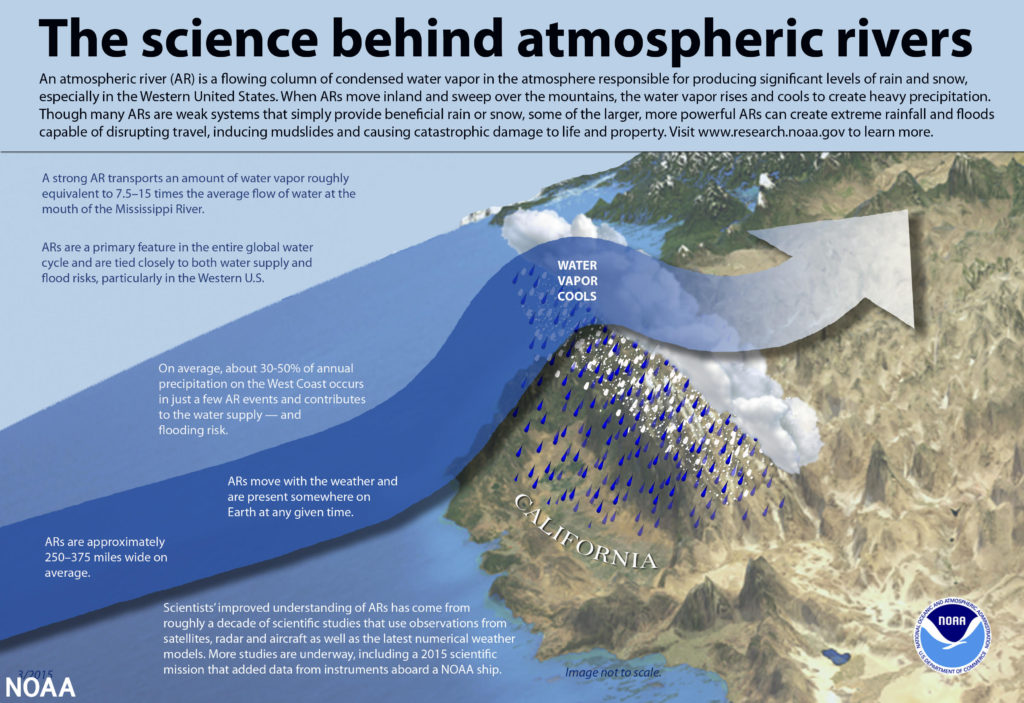
This article is a part of a monthly series called “Finding Sanctuary” in the Santa Cruz Sentinel and Monterey Herald. It was written by Research Ecologist Chad King and MBNMS Superintendent Lisa Wooninck and was published on Feb. 19, 2023 (link)
Nine atmospheric rivers hit California from Dec. 27, 2022 to Jan. 16, 2023, with an average of 12 inches of rainfall, including nearly 40 inches in Santa Cruz. Almost half of the rainfall on the Central Coast entered Monterey Bay National Marine Sanctuary (MBNMS) through rivers and streams, carrying with it millions of tons of natural and human-made debris. Human debris comes in many forms, much of it consisting of lightweight and mass-produced plastic products used by Californians every day.
Perhaps you have seen plastic bags and bottles, food wrappers, cigarette butts, and straws in our rivers and creeks or clogging storm drains after a rainfall. This debris is not only seen on land and on our beaches. Sanctuary scientists, while conducting SCUBA and remotely operated vehicle (ROV) research, have observed a myriad of ocean debris from the surface down to depths of 10,000 feet — bottles, buckets, derelict fishing gear, a shipping container, 100-year old china dishes, a wheelchair, and even a washing machine.
Aside from the eyesore marine debris evokes, plastics may have acute and chronic effects on the marine ecosystem and its inhabitants. Debris entangles whales, is ingested by wildlife, disturbs the seafloor, and releases harmful chemicals during their decay. As plastics in the ocean break down into smaller pieces, they eventually become microplastics: plastic that measures less than five millimeters across (smaller than a grain of rice). Microplastics also come from personal care products, or from synthetic microfibers sloughed off clothing in the washing machine.
Microplastics are a significant threat to both human health and the marine ecosystem, and their distribution is global. For example, MBNMS staff and partners detected microplastics in every ocean sample taken from nearshore and offshore locations of the sanctuary. (https://montereybay.noaa.gov/research/techreports/trkashi2021.html). Fish and shellfish consume microplastics, which then make their way into our food supply. Ingestion of microplastics by marine wildlife may lead to starvation and even endocrine disruption, which can alter the normal functioning of hormones in their bodies and result in several health problems.
Sanctuary staff aim to understand the amount, types, and sources of marine debris through research, and focus on ways to work with coastal and inland communities to reduce these inputs. The sanctuary is coordinating with NOAA’s Marine Debris Program ((https://marinedebris.noaa.gov/our-work/education) and local farmers to reduce the amount of agricultural plastics that enter the sanctuary. Future plans include characterizing the amount and sources of microplastics in Monterey Bay beach sand, working with local agencies to monitor microplastics in wastewater effluent, and developing education and outreach programs to inform the public about the problem. One such early product is an educational StoryMap (https://tinyurl.com/montereybaydebris) on marine debris in the sanctuary.
Everyone working together to limit the source of plastic pollution contributes to keeping the ocean clean and improves the health of our sanctuary, wildlife and humans. The sanctuary encourages you to take action to reduce plastic entering the sanctuary by using reusable bags, water bottles, and containers, and by buying non-plastic products. Beach clean ups organized by our partner Save Our Shores or others is another way to get involved (https://saveourshores.org/beachcleanups/). It’s been immensely gratifying to see the number of beach walkers picking up trash that has washed up on our beaches after the storms that pummeled our coast. THANK YOU! Through collective and individual actions we can address the threat of marine debris and microplastics to our Monterey Bay National Marine Sanctuary.